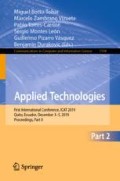Abstract
Human activity recognition (HAR) is important for many applications to help healthcare and support systems due to fast increase of senior population worldwide. This paper describes a human activity recognition framework based on feature selection techniques from a waist single accelerometer. The objective is to identify the most important features to recognize static and dynamic human activities based on module acceleration, since a public database. A set of time and frequency features are getting from the module, so to analyze the impact of the features on the performance of the recognition system, a ReliefF algorithm is applied. Finally, a multiclass classification model is implemented thought Support Vector Machine (SVM). Experimental results indicate that the accuracy of the propose model is over of 85%, this percentage is like other works in which use each axes accelerometer. The advantage of this work is the use of the module value that allow identify the activity independently of the sensor position, also it reduces the computer resources.
Access this chapter
Tax calculation will be finalised at checkout
Purchases are for personal use only
References
Abhayasinghe, N., Murray, I.: Human activity recognition using thigh angle derived from single thigh mounted IMU data. In: 2014 International Conference on Indoor Positioning and Indoor Navigation (IPIN), pp. 111–115. IEEE (2014)
Chen, L., Hoey, J., Nugent, C., Cook, D., Yu, Z.: Sensor-based activity recognition. IEEE Trans. Syst. Man Cybern. Part C Appl. Rev. 42, 790–808 (2012)
Cook, D.J., Das, S.K.: Pervasive computing at scale: transforming the state of the art. Pervasive Mob. Comput. 8, 22–35 (2012)
Campbell, A., Choudhury, T.: From smart to cognitive phones. IEEE Pervasive Comput. 11(3), 7–11 (2012)
Kallur, D.C.: Human localization and activity recognition using distributed motion sensors. Ph.D. thesis, Oklahoma State University (2014)
Motion capture systems - optitrack. https://www.naturalpoint.com/optitrack/
Bao, L., Intille, S.S.: Activity recognition from user-annotated acceleration data. In: Ferscha, A., Mattern, F. (eds.) Pervasive 2004. LNCS, vol. 3001, pp. 1–17. Springer, Heidelberg (2004). https://doi.org/10.1007/978-3-540-24646-6_1
Yatani, K., Truong, K.N.: Bodyscope: a wearable acoustic sensor for activity recognition. In: Proceedings of the 2012 ACM Conference on Ubiquitous Computing, pp. 341–350. ACM (2012)
Yu, C.-R., Wu, C.-L., Lu, C.-H., Fu, L.-C.: Human localization via multi-cameras and floor sensors in smart home. In: Proceedings of the IEEE International Conference on Systems, Man and Cybernetics (SMC), vol. 5, pp. 3822–3827, October 2006
Cheok, A.D., Li, Y.: Ubiquitous interaction with positioning and navigation using a novel light sensor-based information transmission system. Pers. Ubiquitous Comput. 12(6), 445–458 (2008)
Kwapisz, J.R., Weiss, G.M., Moore, S.A.: Activity recognition using cell phone accelerometers. In: Proceedings of the Fourth International Workshop on Knowledge Discovery from Sensor Data (at KDD 2010), Washington DC. WISDM Activity Prediction (2010). http://www.cis.fordham.edu/wisdm/dataset.php
Reyes-Ortiz, J.L., Anguita, D., Ghio, A., Oneto, L., Parra, X.: UCI Machine Learning Repository. https://archive.ics.uci.edu/ml/datasets/Human+Activity+Recognition+from+Continuous+Ambient+Sensor+Data
Kaggle. https://www.kaggle.com/malekzadeh/motionsense-dataset
ExtraSensor. http://extrasensory.ucsd.edu/
Hong, Y.J., Kim, I.J., Ahn, S.C., Kim, H.G.: Mobile health monitoring system based on activity recognition using accelerometer. Simul. Model. Pract. Theory 18(4), 446–455 (2010)
Jimenez, A.R., Seco, F., Prieto, C., Guevara, J.: A comparison of pedestrian dead-reckoning algorithms using a low-cost MEMS IMU. In: Proceedings of the IEEE International Symposium on Intelligent Signal Processing (WISP), pp. 37–42, August 2009
Chernbumroong, S., Atkins, A.S., Yu, H.: Activity classification using a single wrist-worn accelerometer. In: 2011 5th International Conference on Software, Knowledge Information, Industrial Management and Applications (SKIMA), pp. 1–6. IEEE (2011)
Guo, G., Li, S.Z.: Content-based audio classification and retrieval by support vector machines. IEEE Trans. Neural Netw. 14(1), 209–215 (2003)
Gandhi, R.: Support Vector Machine — Introduction to Machine Learning Algorithms, Towards Data Science (2018). https://towardsdatascience.com/support-vector-machine-introduction-to-machine-learning-algorithms-934a444fca47. Acceded 12 Oct 2019
Anderson, I., et al.: Shakra: tracking and sharing daily activity levels with un-augmented mobile phones. Mob. Netw. Appl. 12(2–3), 185–199 (2007)
Anguita, D., Ghio, A., Oneto, L., Parra, X., Reyes-Ortiz, J.L.: Human activity recognition on smartphones using a multiclass hardware-friendly support vector machine. In: Bravo, J., Hervás, R., Rodríguez, M. (eds.) IWAAL 2012. LNCS, vol. 7657, pp. 216–223. Springer, Heidelberg (2012). https://doi.org/10.1007/978-3-642-35395-6_30
Bulbul, E., Cetin, A., Alper, I.: Human activity recognition using smarphones. In: 2nd International Symposium on Multidisciplinary Studies and Innovative Technologies (ISMSIT), Ankara, Turkey (2018)
Anguita, D., Ghio, A., Oneto, L., Parra, X., Reyes, J.: A public domain dataset for human activity recognition using smarphones. In: ESANN 2013 Proceedings on European Symposium on Artificial Neural Networks, Computational Intelligence and Machine Learning, Bruges (2013)
Uddin, M.T., Billah, M.M., Hossain, M.F.: Random forests based recognition of human activities on smarphones. In: 5th International Conference on Informatics, Electronics and Vision (ICIEV), Dhaka, Bangladesh. IEEE (2016)
Ronao, C., Cho, S.: Human activity recognition with smartphone sensors using deep learning neural networks. Expert Syst. Appl. 59, 235–244 (2016)
Najafi, B., Aminian, K., Paraschiv-Ionescu, A., Loew, F., Bula, C.J., Robert, P.: Ambulatory system for human motion analysis using a kinematic sensor: monitoring of daily physical activity in the elderly. IEEE Trans. Biomed. Eng. 50(6), 711–723 (2003)
Hemmati, S.: Detecting postural transitions: a robust wavelet-based approach. In: Annual International Conference of the IEEE Engineering in Medicine and Biology Society (2016)
Ganea, R., Paraschiv-lonescu, A., Aminian, K.: Detection and classification of postural transitions in real-world conditions. IEEE Trans. Neural Syst. Rehabil. Eng. 20(5), 688–696 (2012)
Doulah, A., Shen, X., Sazonov, E.: Early detection of the initiation of sit-to-stand posture transitions using orthosis-mounted sensors. Sensors 17(12), 2712 (2017)
Author information
Authors and Affiliations
Corresponding author
Editor information
Editors and Affiliations
Rights and permissions
Copyright information
© 2020 Springer Nature Switzerland AG
About this paper
Cite this paper
Pilataxi Piltaxi, J.I., Trujillo Guerrero, M.F., Benavides Laguapillo, V.C., Rosales Acosta, J.A. (2020). Human Activity Recognition Using an Accelerometer Magnitude Value. In: Botto-Tobar, M., Zambrano Vizuete, M., Torres-Carrión, P., Montes León, S., Pizarro Vásquez, G., Durakovic, B. (eds) Applied Technologies. ICAT 2019. Communications in Computer and Information Science, vol 1194. Springer, Cham. https://doi.org/10.1007/978-3-030-42520-3_37
Download citation
DOI: https://doi.org/10.1007/978-3-030-42520-3_37
Published:
Publisher Name: Springer, Cham
Print ISBN: 978-3-030-42519-7
Online ISBN: 978-3-030-42520-3
eBook Packages: Computer ScienceComputer Science (R0)

